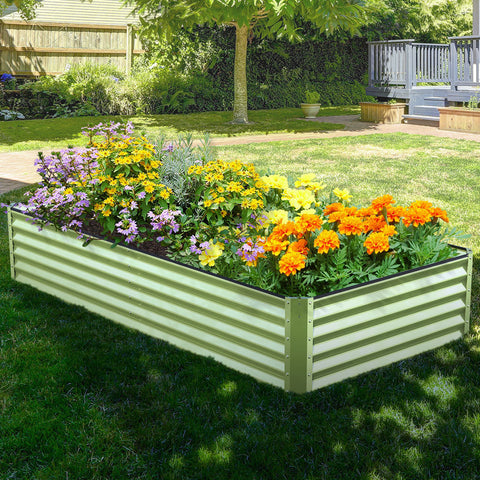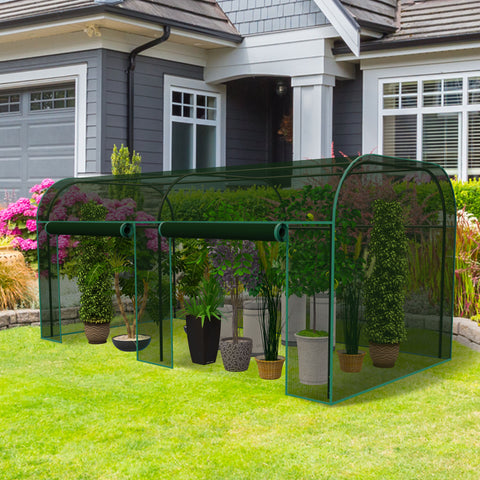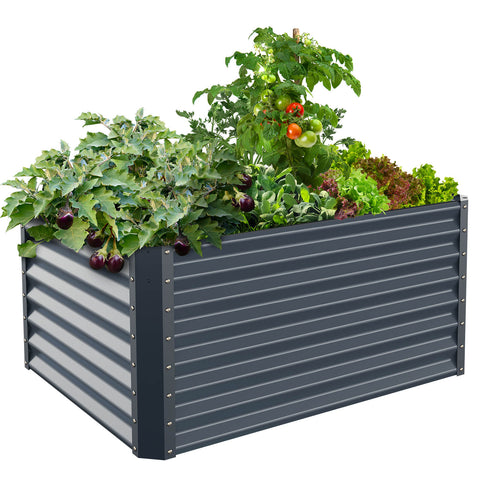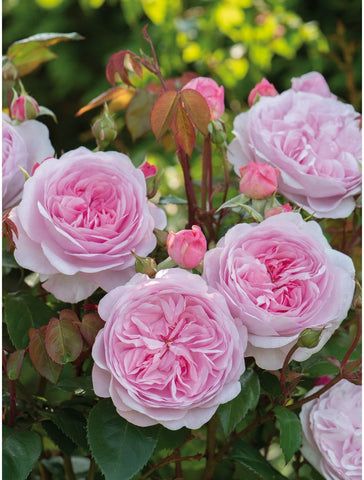In the hustle and bustle of the city, a garden is the dream of many people. However, sometimes our yard is not spacious enough, or the terrain is not ideal, to achieve a large-scale garden. But don't lose heart! Raised Garden Beds are an innovative garden design solution that provides us with a beautiful, practical and relatively small garden solution. It can not only improve the planting conditions, but also increase the aesthetic and ecological environment of the garden. In this article, we will explore how to build raised garden beds to allow our plants to flourish and create our own garden paradise in the city.

Choosing the right location is the first step to build a raised garden bed, which will directly affect the growth environment and aesthetic effect of the garden bed. When choosing a location, you should consider the following key factors:
- Sunshine: Sunlight is one of the important factors for plant growth, and most plants need sufficient sunlight for photosynthesis and growth. Therefore, it is ideal to choose a location that will get full or at least half sunlight. Avoid placing raised garden beds in the shadow of high walls or large trees to prevent plants from getting the necessary sunlight.
- Drainage: Make sure the raised garden bed is built on a slightly higher elevation with good drainage. Avoid low-lying areas where rainwater accumulates and causes water to accumulate on plant roots, causing root rot.
- Wind direction: Consider the wind direction of the garden, especially if you are in an area that often has strong winds. Find a relatively sheltered position to avoid excessive wind damage to the plants. At the same time, be aware that plants can be affected by cold winds, and avoid placing raised garden beds in areas that are vulnerable to cold winds.
- Terrain and landscape: Choose a location that is in harmony with the overall landscape and topography of the garden. Based on the layout and aesthetic requirements of the garden, determine the shape and size of the raised garden bed. Choose a location that highlights the character and makes the raised garden bed the highlight of the garden.
- Easy to manage: Set the raised garden bed in a location that is easy to manage and care for. Convenient regular watering, fertilization, pruning and weeding, etc., to ensure that plants can be taken care of in time.
- Consider the plant's photophilia: When choosing a location, consider the plant's photophilia. Some sun-loving plants need to be placed in a sunny location, while some shade-loving plants need to be placed in a relatively shaded location. Reasonable collocation of plants, so that each plant can meet its growth needs of light conditions.
In conclusion, choosing the right location is a key step in ensuring the success of a raised garden bed. By taking into account factors such as sunlight, drainage, wind direction, terrain, landscape and plant light preference, choosing the best location will help the plant grow healthily and enhance the garden's aesthetic effect.
Design and planning are important steps in building a raised garden bed, which determines the shape, size and layout of the garden bed, as well as the ease of subsequent planting and management. In the design and planning, the following aspects can be considered:
- Determine the shape and size: First determine the shape and size of the raised garden bed. You can choose round, square, rectangular and other different shapes, according to the overall layout of the garden and aesthetic requirements to decide. At the same time, according to the type and number of plants, determine the size of the garden bed to ensure sufficient space for plant growth and development.
- Consider the height difference: When designing a raised garden bed, you can consider setting a multi-level height difference. This can create a sense of hierarchy and three-dimensional, and make the garden more colorful. Note that the height difference should not be too large to avoid uneven plant growth or cause drainage problems.
- Arrange access and boundaries: When planning a raised garden bed, consider the setting of access and boundaries. Reasonable arrangement of channels to facilitate people to enter and exit the garden bed for daily management and viewing. Setting up fences or borders can play a role in beautifying garden beds and protecting plants.
- Consider the plant configuration: When designing and planning, consider the plant configuration. According to the characteristics of plants like light, height and color, the planting position of plants is rationally arranged to create a rich and diverse garden landscape.
- Introduce water features or decorations: If conditions permit, you can introduce decorative elements such as water features, stones, and small Bridges into the raised garden bed to increase the interest and visual effect of the garden.
- Consider seasonal changes: When designing and planning, it is necessary to consider the growth state and flowering period of plants in different seasons. A reasonable selection of plants that bloom in different seasons ensures that the garden bed maintains a beautiful view throughout the year.
Taking the above factors into consideration, the design and planning can help create a unique, beautiful and practical raised garden bed. In the design and planning process, decisions should be made according to the actual situation and personal preferences, while leaving some flexibility to adapt to future garden development and changes.

Identifying the right materials and tools is a key step in building a raised garden bed, the right choice can ensure smooth construction and ensure that the garden bed is stable and beautiful. When determining materials and tools, consider the following aspects:
- Material selection: a. Bedside fence materials: common materials are wood, brick, stone and concrete. Timber side fences can add a natural and welcoming feel, but require regular maintenance. Brick and stone fences can give a strong and durable effect, but require construction skills. The concrete side fence is more plastic and can be designed according to needs. b. Soil materials: Choose high-quality soil suitable for plant growth, you can add leaf soil, decomposed compost or sand to improve soil texture, to ensure that plants have a good growth environment.
- Tools: a. Hammer and screwdriver: Used to secure wood side fences or other fencing materials. b. Shovel or digging tool: used to dig the foundation of the bedside fence or fill the soil. c. Level meter: used to ensure the levelness of the bedside fence. d. Lawn mowers or pruners: for trimming plants and keeping garden beds tidy. e. Wheelbarrow or cart: used to move soil and materials. f. Sunshade net or awning: If shading is required, appropriate shading facilities can be prepared.
- Safety facilities: During construction, attention should also be paid to safety issues. According to the actual situation, you can prepare some safety facilities, such as gloves, goggles, masks, etc., to ensure the safety of the construction process.
- Sustainability considerations: When selecting materials, you can also consider sustainability factors and choose materials that are environmentally friendly and easy to recycle to reduce the impact on the environment.
When determining materials and tools, you should make choices based on your needs, economic budget and construction capacity. If necessary, you can also consult a professional horticulturist or builder for advice to ensure that the process of setting up a raised garden bed goes smoothly.
Preparing soil and filling is an important step in building a raised garden bed, which is directly related to the growth of plants and the stability of the garden bed. When preparing and filling the soil, you can follow these steps:
- Clean the original soil: If there is original soil or plants in the location of the raised garden bed, it is necessary to clean it first and ensure that the construction space and cleanliness of the bedside fence.
- Dig the foundation of the bedside fence: According to the design plan, use a shovel or digging tools to start digging the foundation of the bedside fence. The depth and width of the foundation depends on the selected bedside fence material, in general, the depth of the foundation is about 20-30 cm, and the width is about 30-40 cm.
- Place a drainage layer: Place a drainage layer in the base of the bedside fence to improve the soil drainage. Gravel, sand or small stones can be used as the drainage layer material, ensuring that the thickness of the drainage layer is about 5-10 cm.
- Fill high-quality soil: Fill high-quality soil above the drainage layer to ensure a good growth environment for plants. Choose soil suitable for plant growth, you can add leaf soil, decomposed compost or sand to improve the texture of the soil. The depth of the soil layer depends on the size of the root system of the plant, in general, the depth should be 20-30 cm or more.
- Pay attention to soil uniformity: In the process of filling the soil, ensure that the soil is evenly distributed and there are no large gaps or uneven places. A shovel or wheelbarrow can be used to help fill the soil, while patting the soil gently to make sure it is tightly connected.
- Water regulation: After filling the soil, water should be timely, keep the soil moist, and help the soil closely integrate with the foundation of the bedside fence.
- Consider soil adjustment: If the selected plants have higher requirements for the soil, the pH value of the soil can be adjusted according to the need or the addition of appropriate nutrients to provide a more suitable growth environment.
In the process of preparing the soil and filling, care should be taken to ensure the stability of the bedside fence and the quality of the soil. Proper soil preparation and filling can provide good growing conditions for plants and make the raised garden bed glow with a beautiful scene of blooming flowers.

The construction of fences and borders is an important step in building a raised garden bed, which not only protects the stability of the garden bed, but also adds to the beauty and overall shape of the garden. When building fences and borders, you can follow these steps:
- Choose the fence material: According to your own preferences and garden style, choose the right fence material. Common fencing materials are wood, brick, stone and concrete. Wood fences can create a warm and natural feel, while brick and stone fences can add a strong and stable effect, and concrete fences are more malleable and can be designed as needed.
- Measurement and marking: Use measuring tools to measure and mark the position of the bedside fence according to the size of the design plan. Ensure the accuracy and consistency of the fence position.
- Build fence frame: According to the marked location, use wood, brick or stone and other materials to build the frame of the fence. If a wood fence is used, the fence plate can be assembled first and then fixed on the ground. If a brick or stone fence is used, it can be stacked layer by layer, taking care to keep the fence stable and level.
- Fixed fence: According to the characteristics of the fence material, use the appropriate fixing method to ensure that the fence is stable and not tilted. If it is a wood fence, screws or nails can be used to secure the fence board to the ground. If it is a brick or stone fence, cement mortar can be used to bond the bricks or stones together to increase the stability of the fence.
- Consider boundary aesthetics: In addition to the stability of the fence, also consider the boundary aesthetics of the fence and garden bed. Materials such as wood, brick or stone can be used to create clean, regular border lines.
- Add decorations: If you want the fence to be more beautiful, you can add some decorative elements to the fence, such as vines, flowers, stone carvings, etc., to increase the interest and uniqueness of the garden.
When constructing fences and borders, pay attention to the stability and aesthetics of the fence, and ensure that the overall effect of the fence and the garden bed is coordinated. At the same time, it is also necessary to make the necessary construction preparations according to the characteristics of the fence material and construction skills to ensure the smooth construction process.
Planting and maintenance is an important link after building a raised garden bed, which is related to the growth of plants and the beauty of the garden. In the process of planting and maintenance, the following measures can be taken:
- Choose the right plant: According to the light condition, soil characteristics and climate conditions of the raised garden bed, choose the right plant species. Consider the plant's light tolerance, shade tolerance and stress resistance to ensure that the plant can grow healthily in its environment.
- Planting tips: When planting plants, pay attention to digging the appropriate size of the planting pit, and put the plant roots properly in it. After filling the soil, pat the soil gently to make sure the plant is firmly in place. When planting, you can add an appropriate amount of organic fertilizer or slow-release fertilizer according to the growth needs of the plant to help the plant grow better.
- Watering: In the initial stage after planting, maintain a moderate amount of watering to ensure that the plant roots fully absorb water and take firm roots. With the growth of plants, according to the needs of different plants and climate conditions, reasonable adjustment of watering frequency and amount to avoid too much or too little water.
- Fertilization: Regular fertilization is an important guarantee for the healthy growth of plants. According to the growing season and needs of plants, choose the appropriate fertilizer for fertilization. Organic and slow-release fertilizers are ideal for providing balanced nutrients to plants.
- Weeding: Regularly remove weeds from the garden bed and keep the bed clean. Weeds not only compete for water and nutrients, they can also harm plant growth.
- Pruning and pruning: According to the growth characteristics of plants and flowering, regular pruning and pruning. Pruning can promote the growth of new branches, pruning can keep the plant shape beautiful and avoid overdense growth.
- Disease and pest control: closely observe the growth of plants, timely find disease and pest problems, and take corresponding prevention and control measures to protect plant health.
- Keep the environment clean: keep the environment around the raised garden bed clean, remove fallen leaves and debris, and avoid affecting the beauty and hygiene of the garden.
Planting and maintenance is an ongoing process that requires patience and careful care. With proper planting and maintenance, the raised garden bed will become a beautiful green corner to bring you pleasure and joy.

In the process of building a raised garden bed, there are some precautions and common problems to pay attention to to ensure the smooth construction of the garden bed and the healthy growth of the plants. Here are some things to look out for and common problems you may encounter:
Note:
- Stable foundation: Ensure that the foundation of the bedside fence is dug to a sufficient depth, and the drainage layer and soil are filled to ensure the stability of the bedside fence.
- Sufficient sunshine: Choose the right location to ensure that the raised garden bed can get sufficient sunlight to meet the growth needs of plants.
- Consider the light-loving nature of plants: reasonable collocation of plants, according to the light-loving nature of plants, the sun-loving plants are placed in direct sunlight, and the shad-loving plants are placed in a shady position.
- Proper drainage: Ensure that the garden bed has a good drainage system to avoid damage to plants due to waterlogging.
- Avoid overwatering: Overwatering can cause water to accumulate on the roots of plants, causing root rot. According to the water needs of plants, control the amount of water.
- Regular pruning: Regular pruning and pruning to maintain the beautiful shape of the plant and promote new growth.
- Prevention and control of diseases and pests: closely observe the growth of plants, timely find and deal with diseases and pests, and protect the health of plants.
Common problems:
- Plants wilting: It may be due to too much or too little watering, or the plant has been damaged by pests and diseases.
- Poor soil quality: Poor soil quality may lead to poor plant growth. Need to add organic fertilizer or soil improvement.
- Unstable fence: The foundation of the fence is not excavated to a sufficient depth or is not properly fixed, resulting in unstable fence.
- Weed growth: not weeded in time, resulting in too many weeds in the garden bed, affecting the growth of plants.
- Insufficient light: Improper location leads to insufficient light in the garden bed, affecting the growth and flowering of plants.
- Diseases and pests: plants are affected by diseases and pests, which may lead to problems such as yellow leaves and wilting branches.
In the face of these problems, corresponding measures can be taken in time to deal with, such as adjusting the amount of watering, improving the quality of soil, timely weeding and prevention and control of diseases and pests. At the same time, regular inspection and maintenance of garden beds and daily management can effectively avoid the occurrence of these common problems.
In the warmth of the sun, our raised garden bed becomes an oasis of life, where all kinds of flowers and trees bloom to reflect our dreams and efforts. By building raised garden beds, we found that even in a limited space, it is possible to create a beautiful and vibrant garden. This small garden bears our love for nature and our passion for life.
In this raised garden bed, we not only feel the vitality and charm of plants, but also appreciate the fun of labor and the joy of creation. Every ploughing and watering is the care and companionship of life. Here, we establish a special relationship with plants, living and thriving together.
Let us not forget the original intention, continue to care for this garden. Let us touch the life of plants with warm sunshine and delicate hands, so that they grow and thrive under our care. Let us decorate this land with beautiful flowers and lush green leaves, making them a beautiful sight in the city.
In the raised garden bed, we find a reverence for nature and a reverence for life. In this little garden we find the beauty and joy of life. Let us continue to take good care of this garden, so that it can bloom more beauty and hope in our lives.
Let's build more raised garden beds and let this beauty continue to spread, so that every corner of the city is full of life and vitality. Because here, we not only create a garden, but also create a dream world. Let us enter this garden together, with love and enthusiasm, let the dream flourish, let the beauty stay forever!









